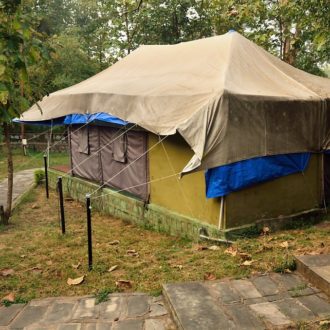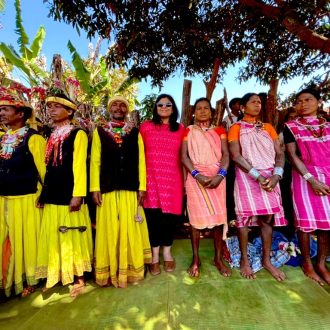From temples to castles – Places to see around Gwalior

The massive medieval Gwalior Hill Fort headlines Gwalior in Madhya Pradesh and is a city by itself with palaces, temples, step-wells, and rock-cut caves with colossal carvings. While the Chaturbhuj temple inside the Gwalior Fort houses the oldest inscription of zero, the blue-glazed tiles adorning the Gwalior Fort and the Man Mandir Palace add a touch of colour to the towering edifice. But Gwalior is more than just the fortress. And while the bustling town with markets, mausoleums, and museums beckons you to stay for at least three days, I would recommend a week in Gwalior as there are several places to see around Gwalior, with hidden heritage gems. I was recently on a tour with Times Passion Trails exploring the heritage destinations around Gwalior with renowned archaeologist, KK Muhammad Sir as our “Experience Architect” and we visited Morena, Shivpuri, and Datia among other destinations as well If you are planning a trip to discover hidden heritage destination around Gwalior, here is a quick itinerary for you with some of the places to see around Gwalior, which includes Temples in Morena, Bateshwar Group of Temples, Datia Palace, Scindia Chhatris among other monuments.
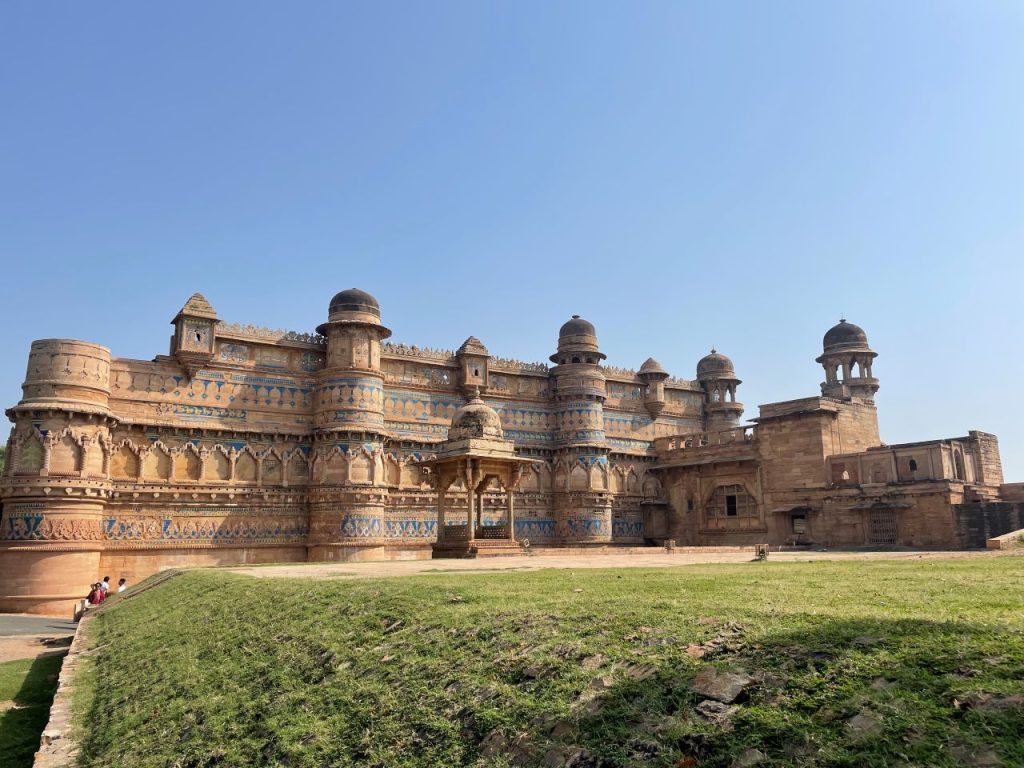
Places to see in Morena
Located 39 km from Gwalior and in the Chambal Valley, Morena is my personal favourite with several fascinating and hidden temples. Once ravaged by dacoits, Morena is named after the many peacocks who flock here – Morena literally translates to a place where peacocks live. However we journeyed to Morena, not to do some birdwatching but to explore some of the most ancient heritage gems like the Bateshwar Group of Temples, Chausath Yogini Temple at Mitaoli, the Padavali temple, and the breathtaking Kakanmath Temple at the Sihoniya village. You can do a day trip from Gwalior to Morena but start your day as early as possible. Most of these temples of Morena are over 1000 years old, built around the 9th-11th centuries by the Gurjara Pratihara and the Kachchhapaghata dynasties. These shrines are waiting to be discovered and you feel like you are walking into a lost piece of forgotten history where you explore these heritage gems. Here are some of the main heritage destinations and places to see in Morena.

Bateshwar Group of Temples
I don’t even know where to begin as I start writing about the Bateshwar Group of Temples built between the 9th and 11th centuries. Words fail me as I stand there mesmerized. Should I tell you about the marvels of the Gurjara Pratihara Dynasty who built around 200 temples, dedicated mainly to Bhagwan Shiva and Bhagwan Vishnu, or about how they had fallen like a pack of cards, presumably because of an earthquake and were swallowed by the jungles and discovered centuries later by dreaded dacoits who had made it their hideout or about the dedicated and undaunted story of the restoration of 80 temples by a few brave men, led by acclaimed archaeologist, Padmashri KK Muhammad Sir and his team in a dacoit infested area?
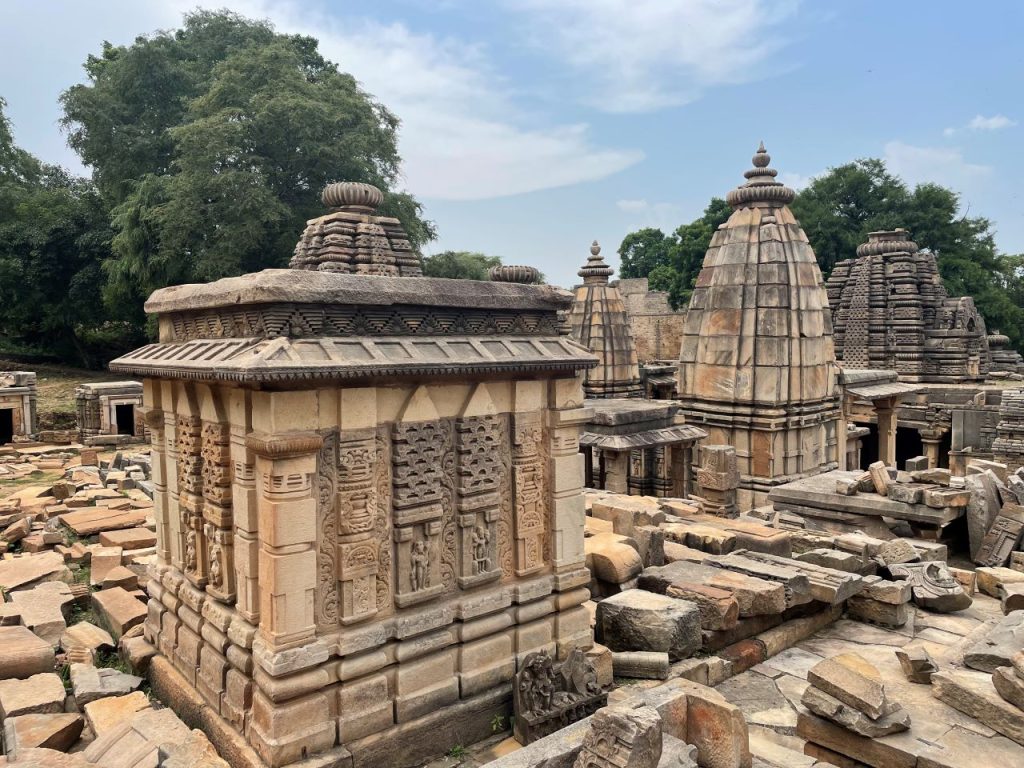
You can read about the restoration story in an interview that I did with KK Muhammad Sir in this blog which gives you a brick-by-brick account of how the temples were rebuilt from shambles. Even today, 100 temples are still in crumbles as KK Muhammad hopes that this will soon be completed as well. Located about 40 km from Gwalior, I would strongly recommend that you visit the Bateshwar temples at least once in your lifetime. It is an incredible experience, just being here. If you are planning to explore places around Gwalior but have time for just a destination then ensure Bateshwar is on your list.
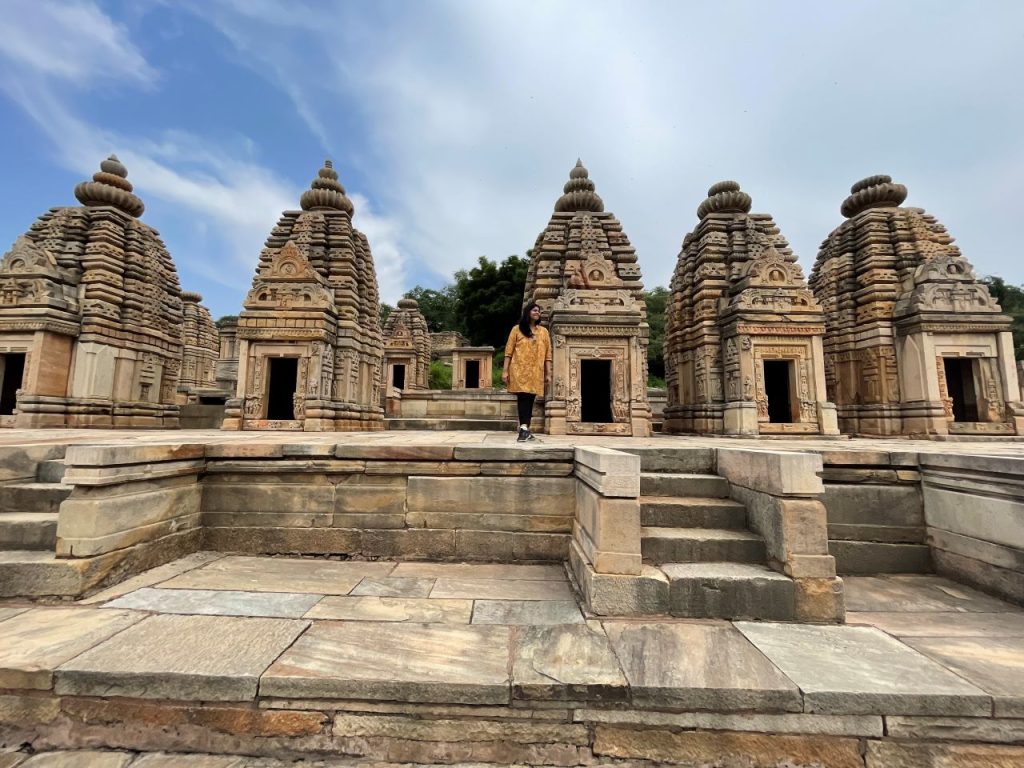
Chausath Yogini Temple – Mitawali ( Mitaoli)
I have always been fascinated by Chausath Yogini Temples. There are very few of these ancient tantric temples left today and they are mainly found in Madhya Pradesh and Odisha. Dedicated to Maa Durga ( the 64 Yoginis are believed to be Tantric manifestations of Maa Durga) they are brimming with feminine energy. Most of these shrines are circular in design referred to as a hypaethral style of architecture and there are separate niches to house the deities.
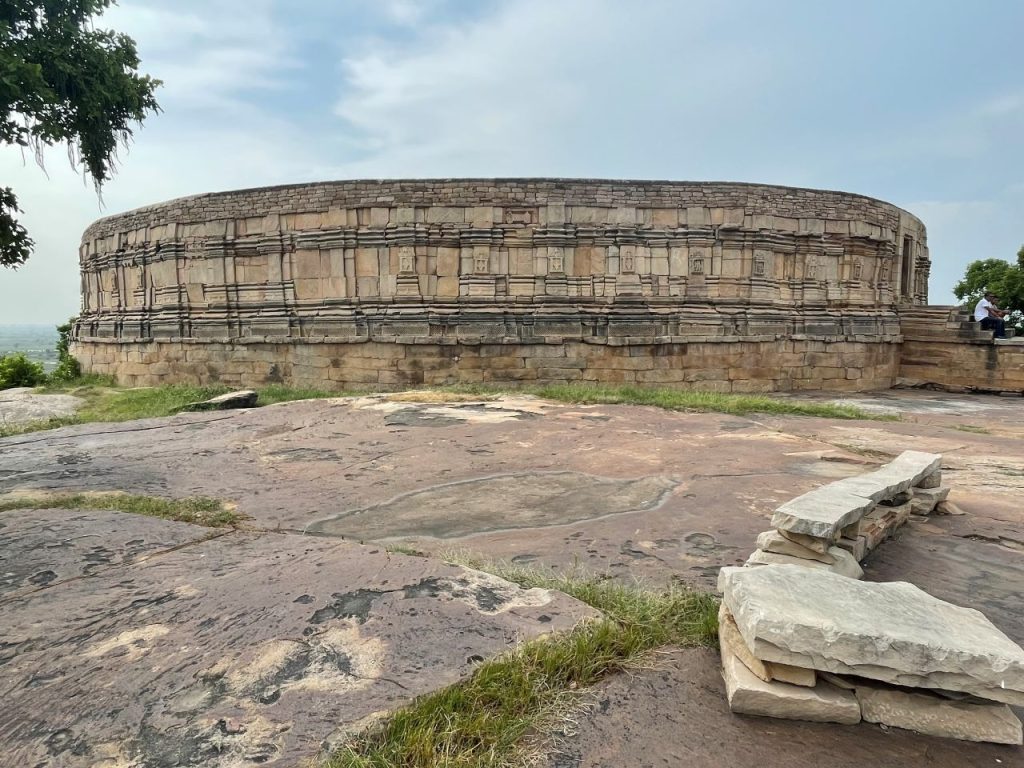
Located atop a hill in the Mitaoli ( Mitawali or Mitavali) village, about 35 km from Gwalior, it is a bit of a climb with 100 steps to the summit. You can see a circular wall and as you enter through a small door, you can see about 64 chambers or niches carved in the wall, for the deities. Most of these chambers are however empty today, while some of them have Shiva Lingas placed inside them. An old temple, dedicated to Bhagwan Shiva stands in the centre of the courtyard and hence it is also named Ekattarso Mahadev temple.
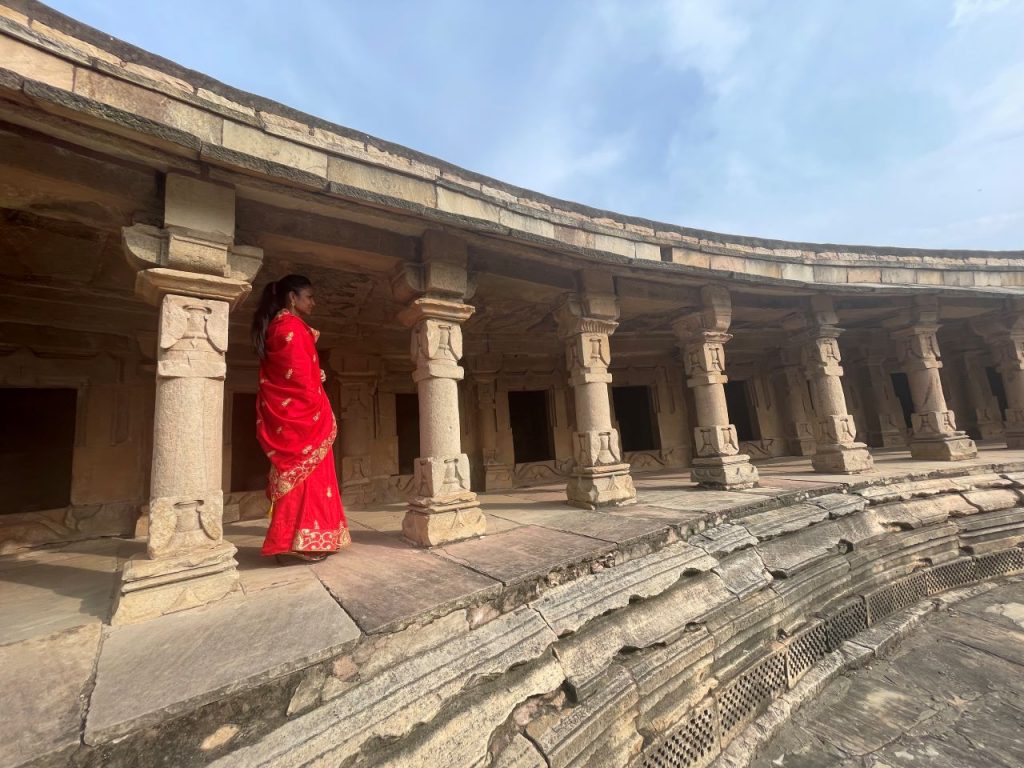
It is believed that the circular design of the Yogini Temple inspired the architecture of the old Parliament Building as well. The temple was built over 1000 years in the 11th century by the Kachchhapaghata king, Devapala, and was believed to have been an education centre to teach mathematics, astrology, and astronomy according to the Vedic tradition.
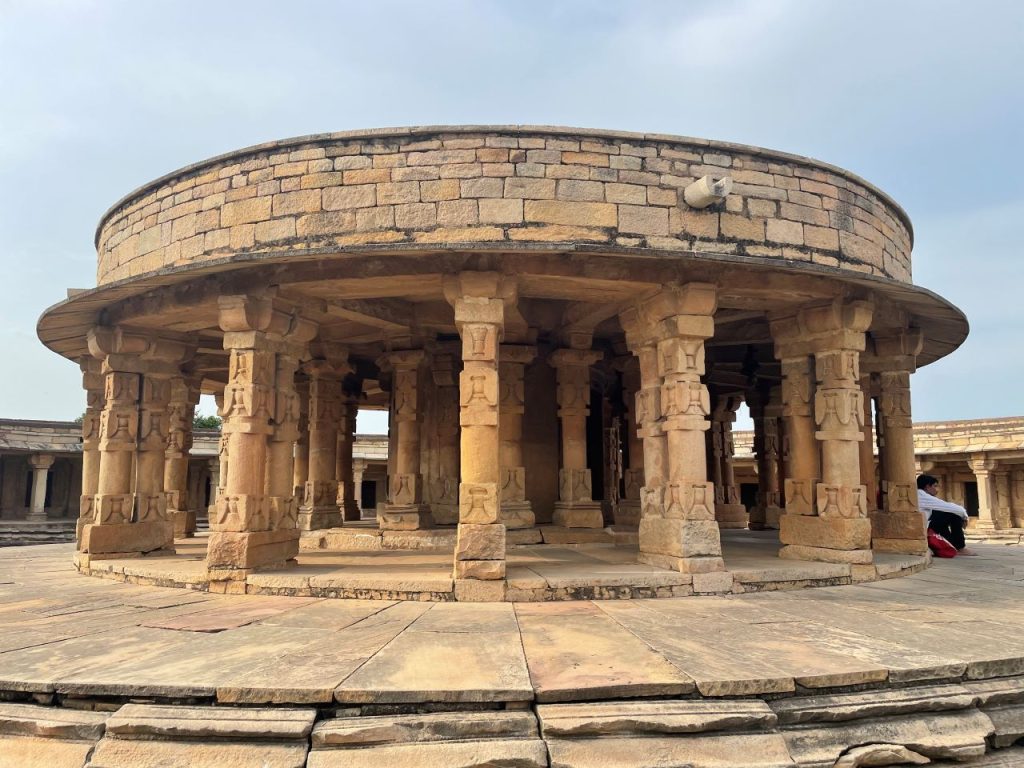
Madhya Pradesh is home to over three Chausath Yogini Temples and you can also see them in Jabalpur and Khajuraho as well.
Garhi Padavali
The magic of Garhi Padavali ( Padawali ) can be seen in the sheer poetry of stone carvings and panels of sculptures that give a three-dimensional effect. Located very close to Mitava;i. Padavali is a fortress that houses the remnants of an ancient Shiva temple dating to the 10th century probably during the era of the Kachchhapaghata kings. While there is neither a sanctum nor a main deity here, the fortress flanked by two carvings of massive lions was built much later in the 19th century.

However, all eyes are peeled onto the ceilings and walls of the temple which burst into panels with carvings depicting a pantheon and deities. The trinity – Bhagwan Vishnu, Brahma, and Mahadev are carved in one of the panels, while in another, you can see the divine wedding of Bhagwan Shiva with Ma Parvati. One panel depicts scenes from the Ramayana where you can see Bhagwan Rama with his army performing a puja, while there are also other friezes depicting battle scenes from Mahabharata. The Chamunda panel and Samudra Manthan carvings are no less beautiful. All the sculptures have such detailing and they give you a 3D effect.
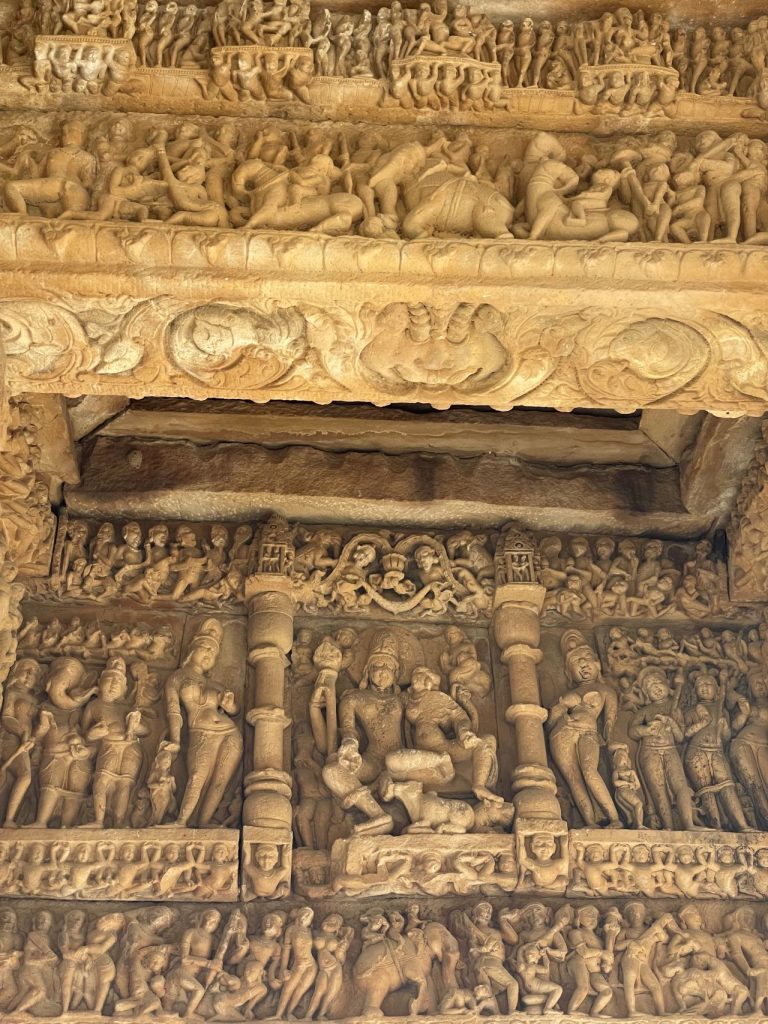
Mitavali and Padavali virtually next to each other are nestled in the Morena district near Gwalior and you can visit them after exploring the Bateshwar Group of Temples. KK Muhamad Sir and his team also worked on the restoration of the temple in Padavali where every inch of the temple – from pillars, and beams, to ceilings, is decorated with carvings.
Kakanmath Temple
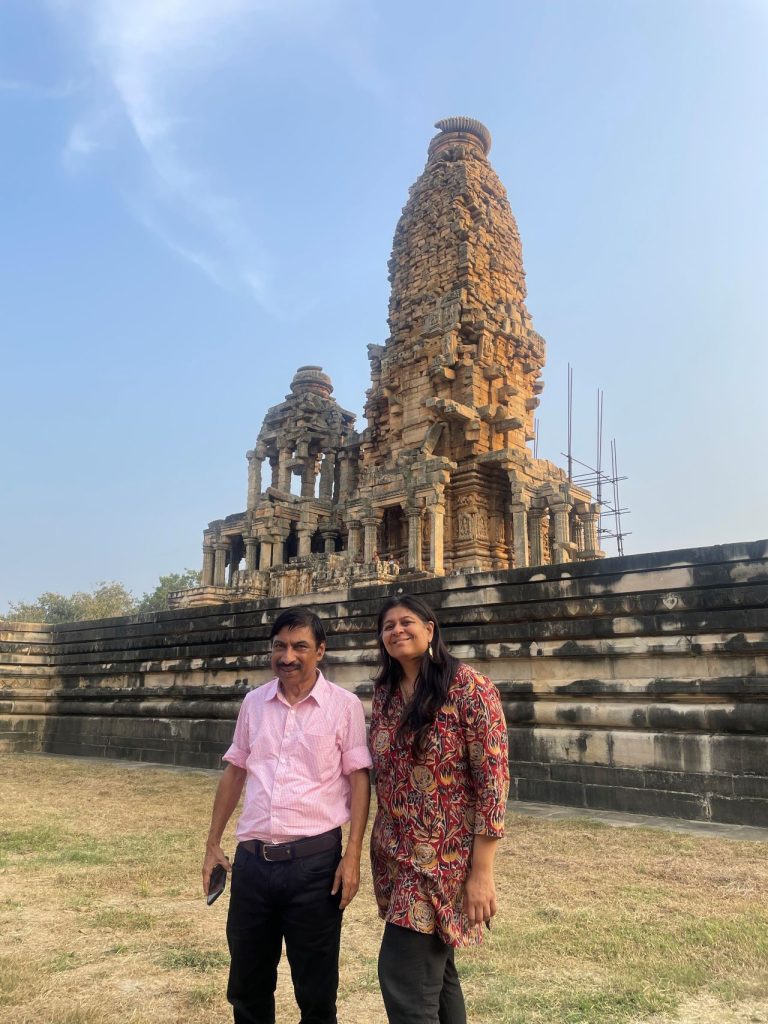
Surreal and breathtaking, this 1000-year-old Shiva temple built in the 11th century challenges the very laws of gravity. Tucked away in a village called Sihoniya near Gwalior in Madhya Pradesh, it is an absolute wonder, Towering over 100 feet, the temple is just a stack of bricks piled on top of each other and has been built without any adhesive material like lime or cement. If you crane your neck and look above, all that you can see is a pile of stones stacked atop each other and you wonder how the temple has been standing tall like this for over 600 years.
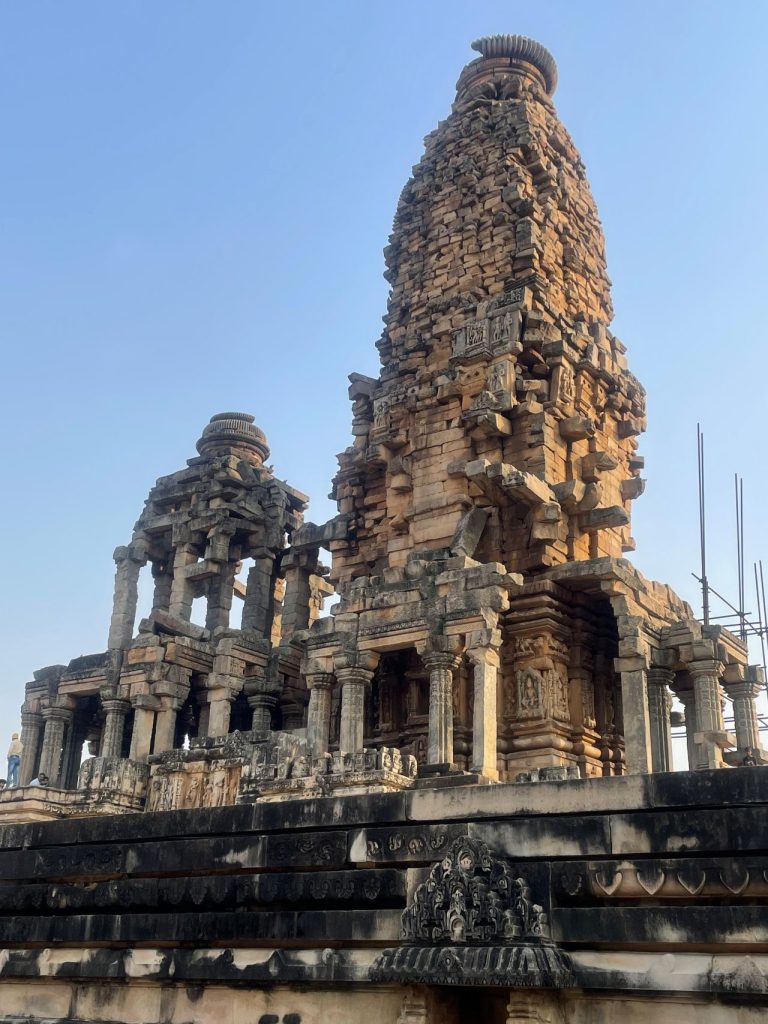
Legends of course ghosts and demons helped build the temple adding a supernatural dimension to the mystery of this incredible temple. Another local legend says that the temple is called “the Temple of Gold” and it was named after one of the queens, Kakanavati who was a Shiva devotee.
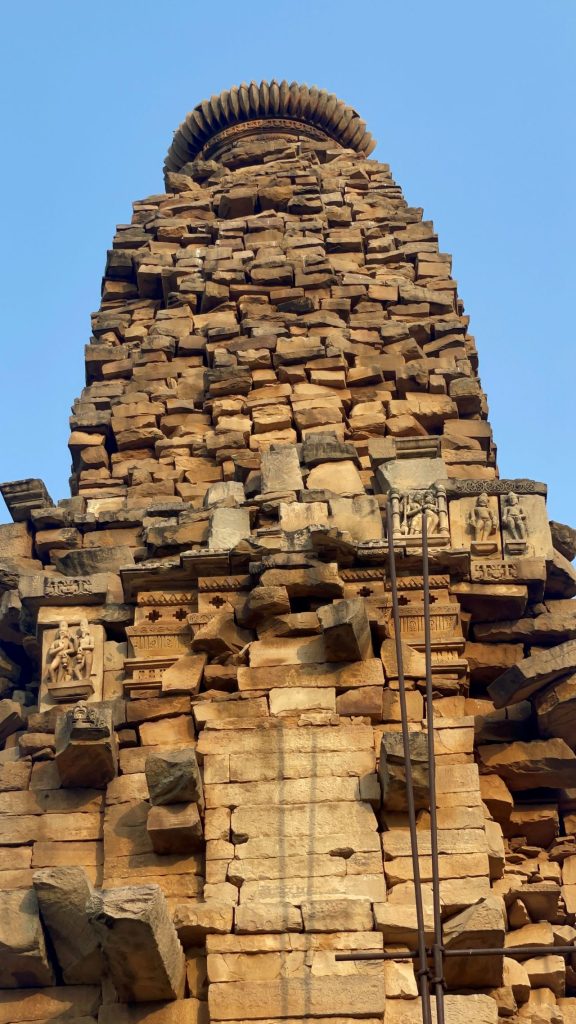
Some historians however say that the Kachchhapaghata ruler Kirttiraja built the temple in the 11th century. An inscription at the Saas Bahu temple in the Gwalior Fort refers to a Shiva temple built at Siṁhapānīya, which is believed to be the present-day Sihoniya.
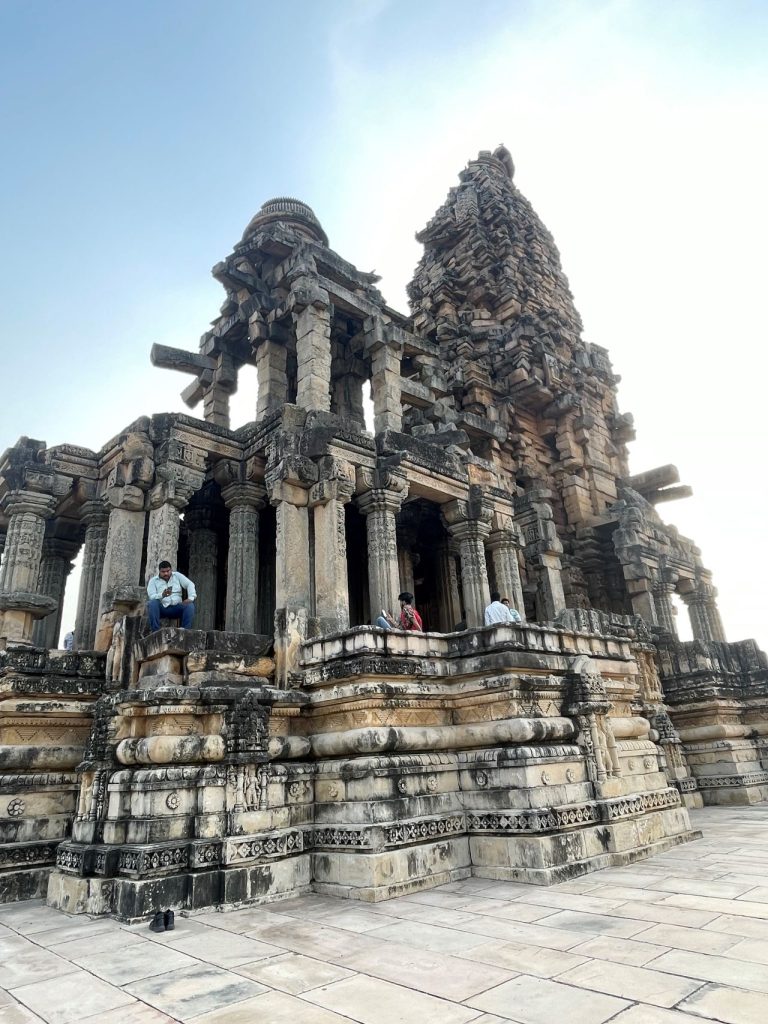
There is a pillared corridor that leads to a central shrine with a Shiva Linga inside it. However, the carvings on the outer walls are absolutely poetry in stone. There were probably smaller temples around the temple but they seem to have not withstood the ravages of time. KK Muhammad Sir explained that restoration should start soon here as well. Dont miss this fascinating temple while exploring places around Gwalior.
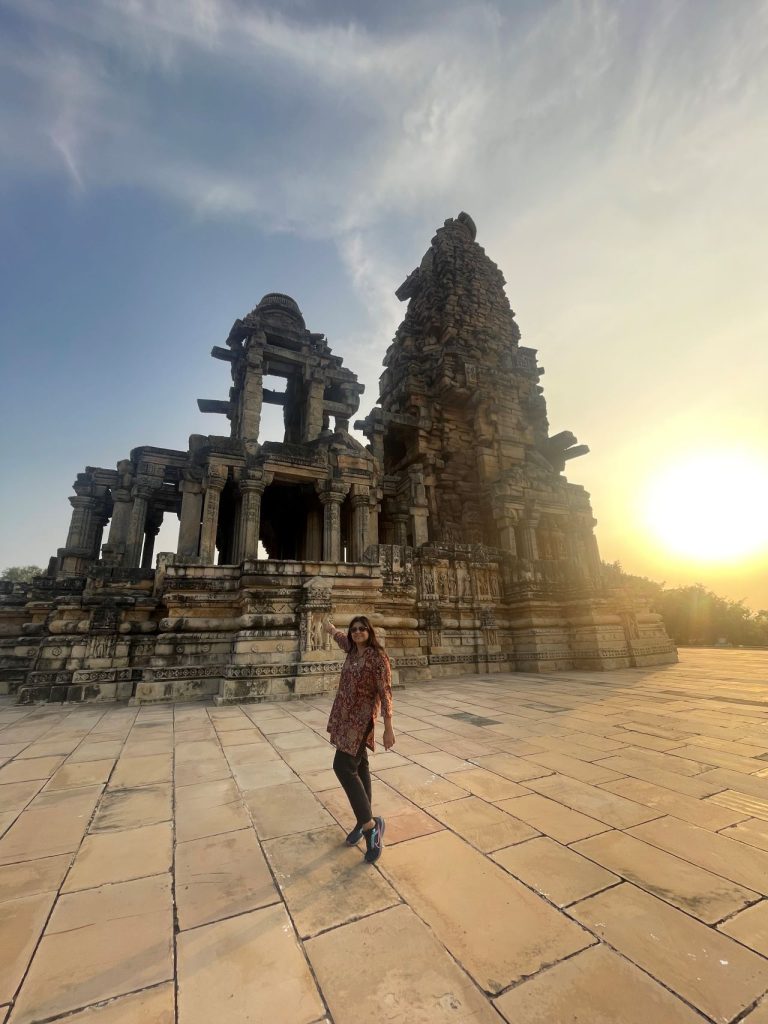
We were here during sunset and the evening rays added a mystical aura around this stunning masterpiece.
Places to see in Shivpuri
Shivpuri is an ancient city, earlier known as Sipri, and is located jus t115 km from Gwalior. It was believed that Bhagwan Shiva had lived in this town which was home to several ancient temples and hence it got its name, Shivpuri. Shivpuri is not just about monuments but is also a nature lover’s paradise. The Madhav National Park covers an area of 167 sq km and standing tall amidst the dense woodlands is the George Castle built by the Scindias for King George V.
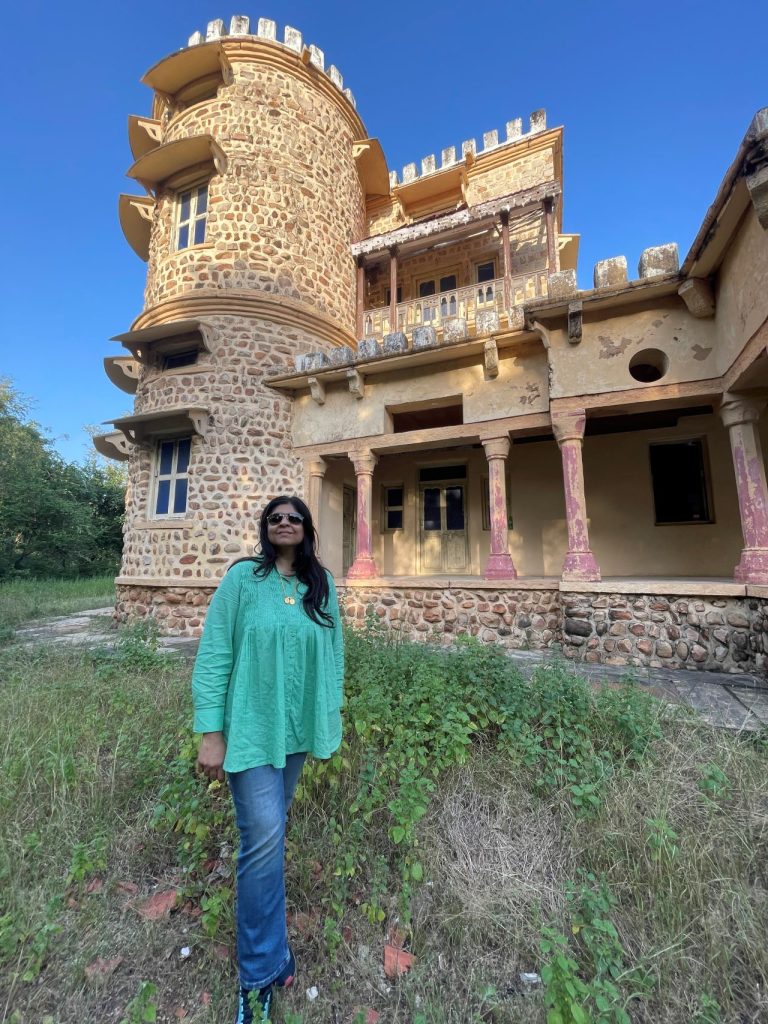
Shivpuri became the resort town of the Scindias surrounded by lakes and forests and the chhatris or tombs of the royal family are located here. Even the Mughals used to visit the forests for their hunting. However, to get a glimpse of the ancient town, one must visit Survaya Ki Garhi, located 20 km away from the city and is a treasure trove of temples and monasteries.
Surwaya Ki Garhi
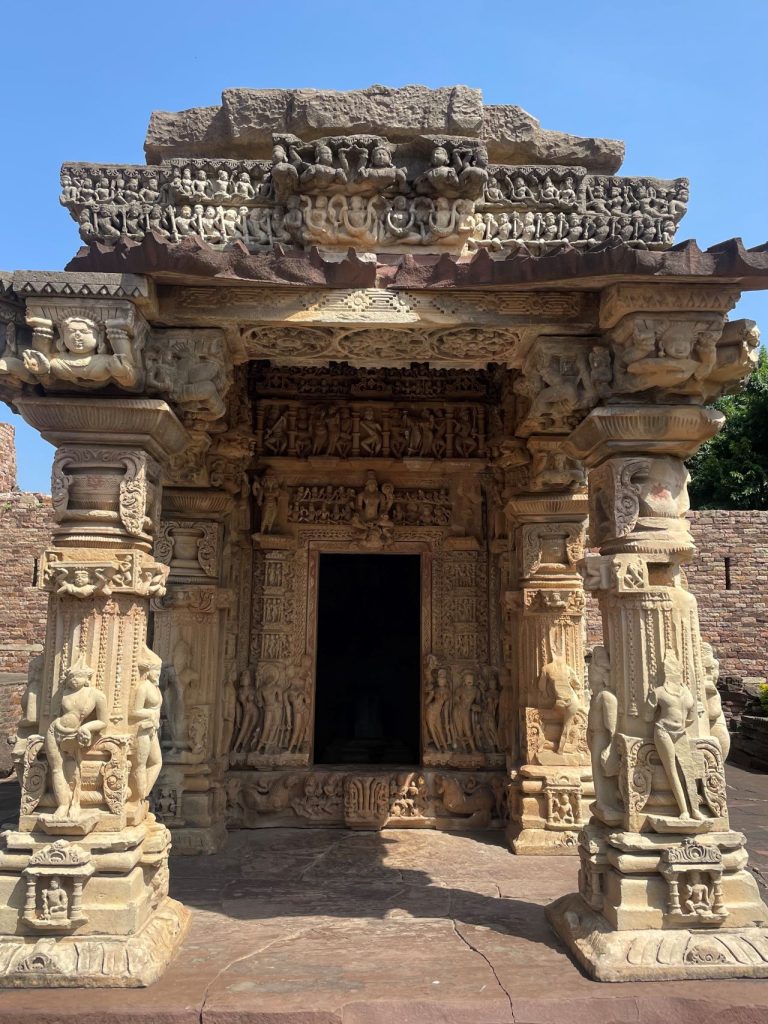
Surwaya ki Garhi, located 20 km away from Shivpuri is truly a hidden heritage gem in many aspects. When you enter this heritage site through the fortified walls and gates, you feel that you are entering a formidable fortress. But the portals open into a vast complex filled with temples and monasteries. It is definitely one of the places to see around Gwalior.
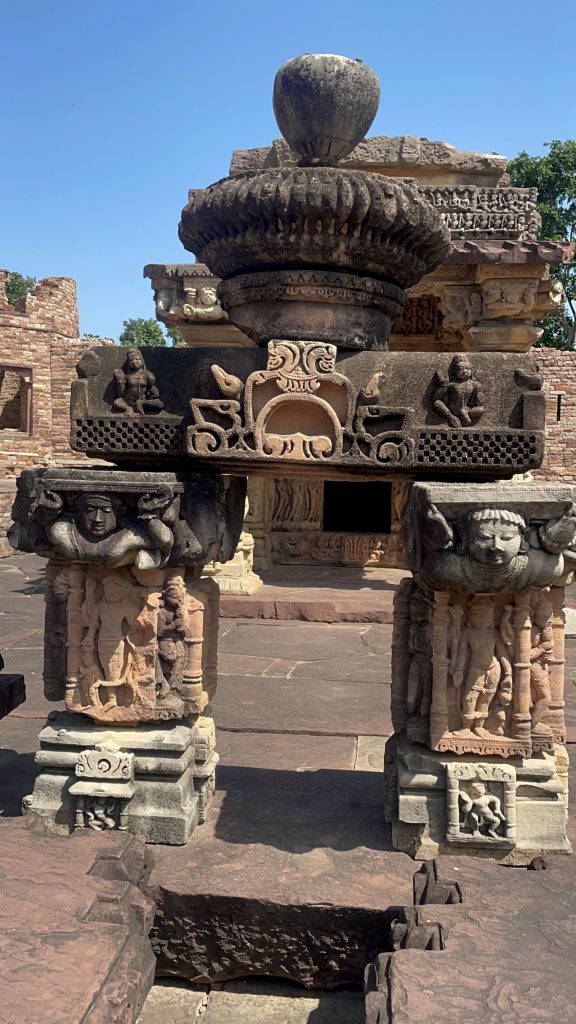
Built around the 10th -11th century, this was identified as an ancient Saraswati Pattana and was one of the earliest learning centres as well. I felt like a time traveller, lost somewhere in the medieval era. Walking around, it seemed like an open-air museum of heritage monuments with e exquisite carvings on temples, pillars, step-wells, and monasteries.
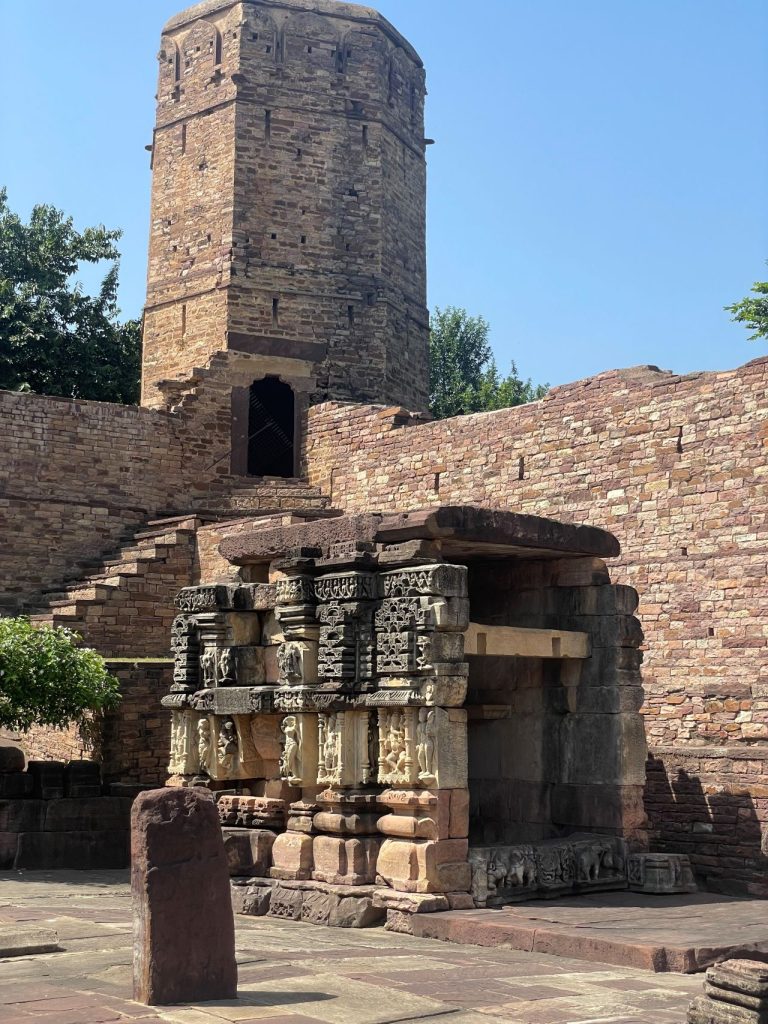
Chhatris of Scindias
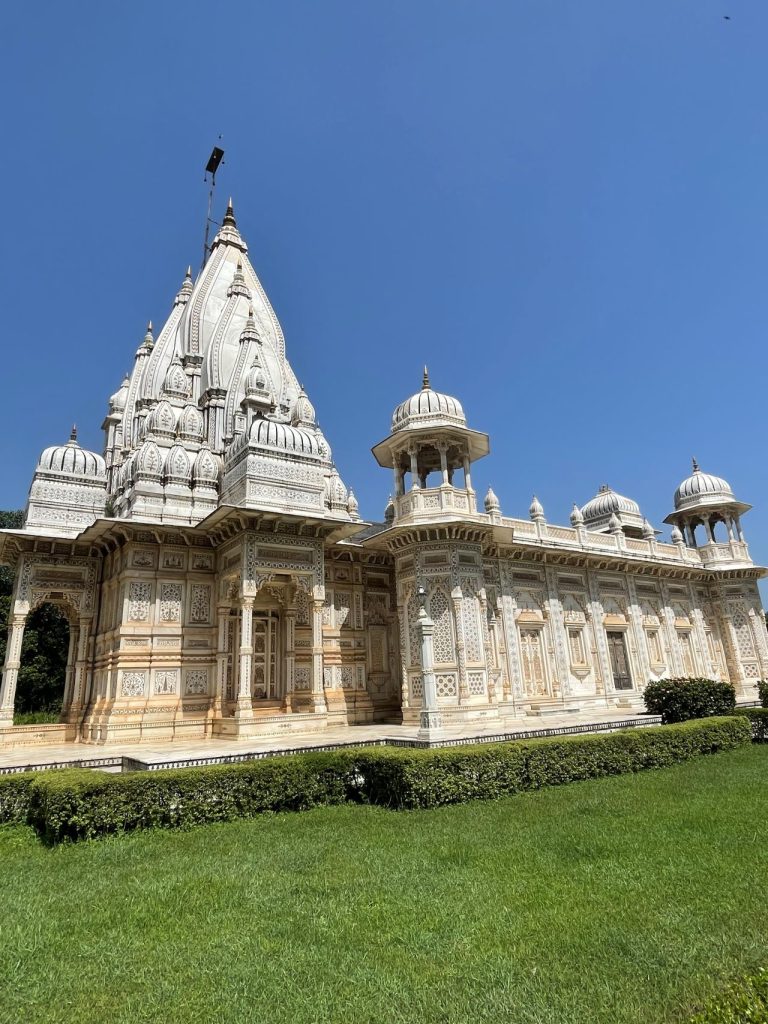
Set in a verdant landscape of gardens and ponds are the breathtaking Chattris of the Scindias carved in marble, blending different styles of architecture. They are exquisitely designed with Mughal-styled pavilions and spires as you see in Hindu temples surrounded by pools, and gardens and connected by paths and walkways.
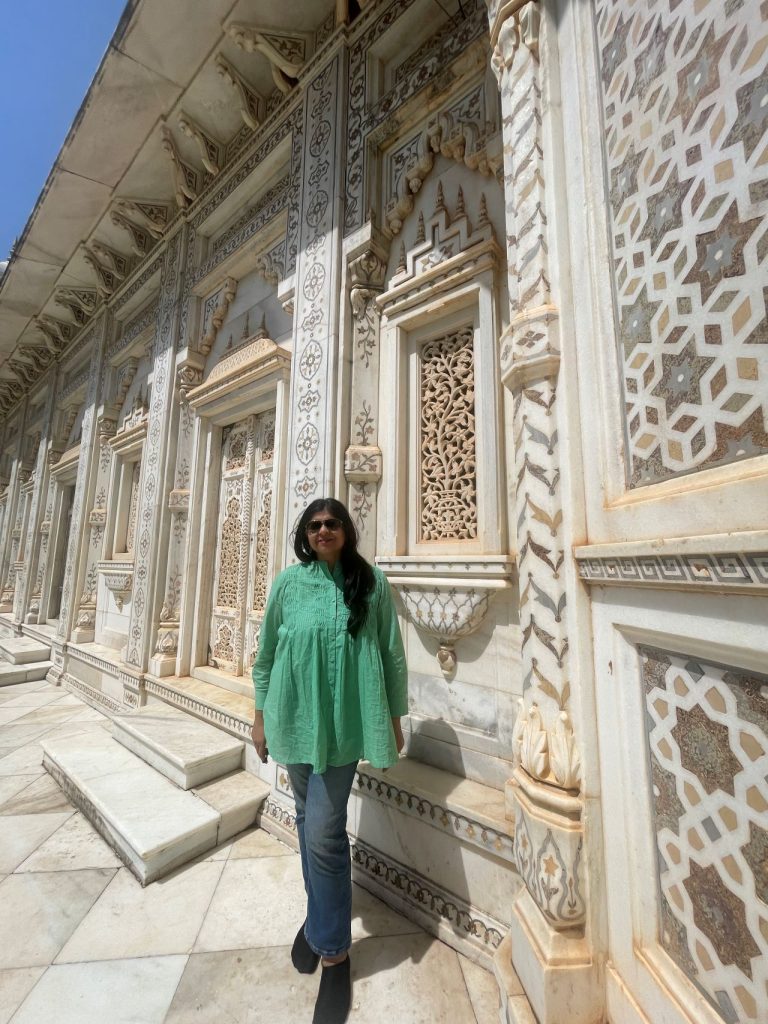
Shivpuri has always been a royal residence with the forested woods of Madhav National Park as the royal hunting grounds and it is only befitting that the Chhatris or tombs of the Scindhias are built here.
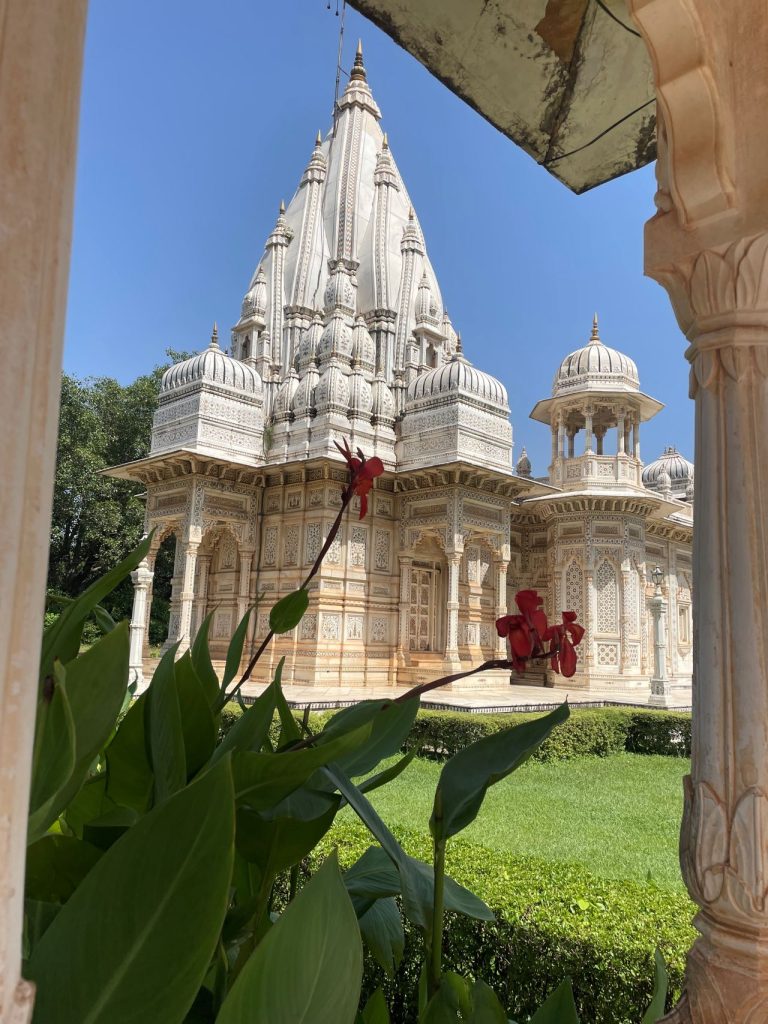
The Chhatri of Maharaja Madhorao Scindia built in the late 1920s is an architectural marvel and is known for the inlay work on the marble with precious and semi-precious stones. The Chhatri of the Maharani Sakhya Raje Scindia is one of the most exquisite monuments as well.
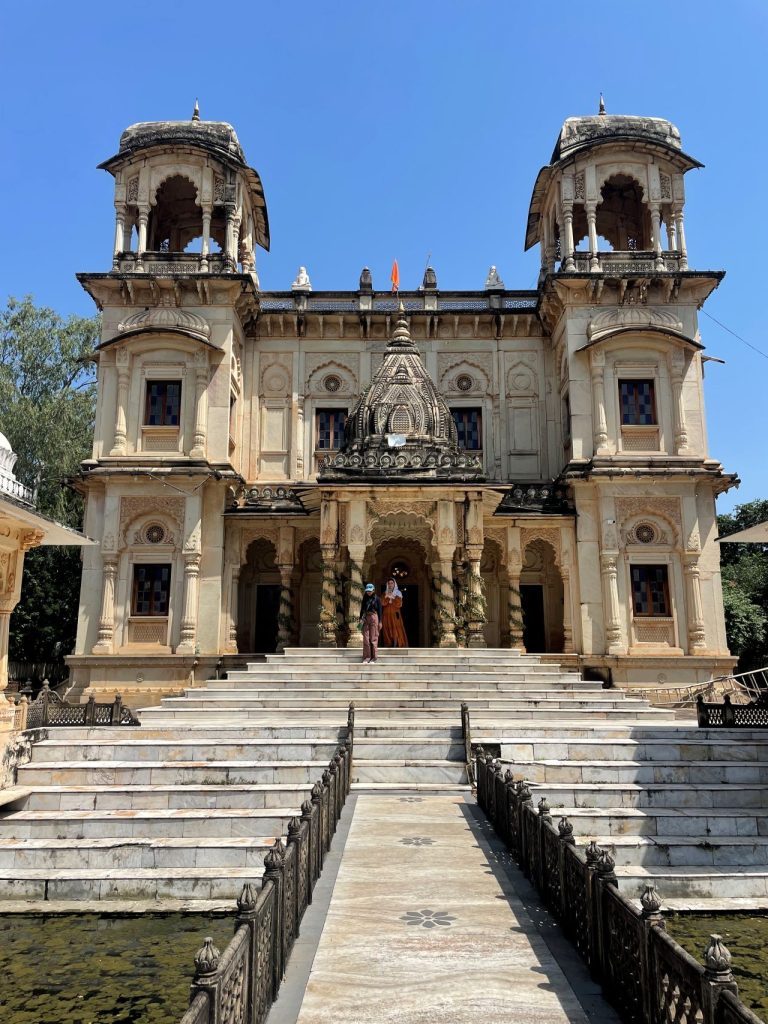
George Castle
A little bit of Europe in the heartland of India, St George’s Castle was a complete surprise for me. Little did I expect that in the dense forests of Madhav National Park, I would find an English castle at its highest point ( 1587 feet) . Built almost a century ago by Jivaji Rao Scindhia for British King George V when he came here for a hunting expedition.
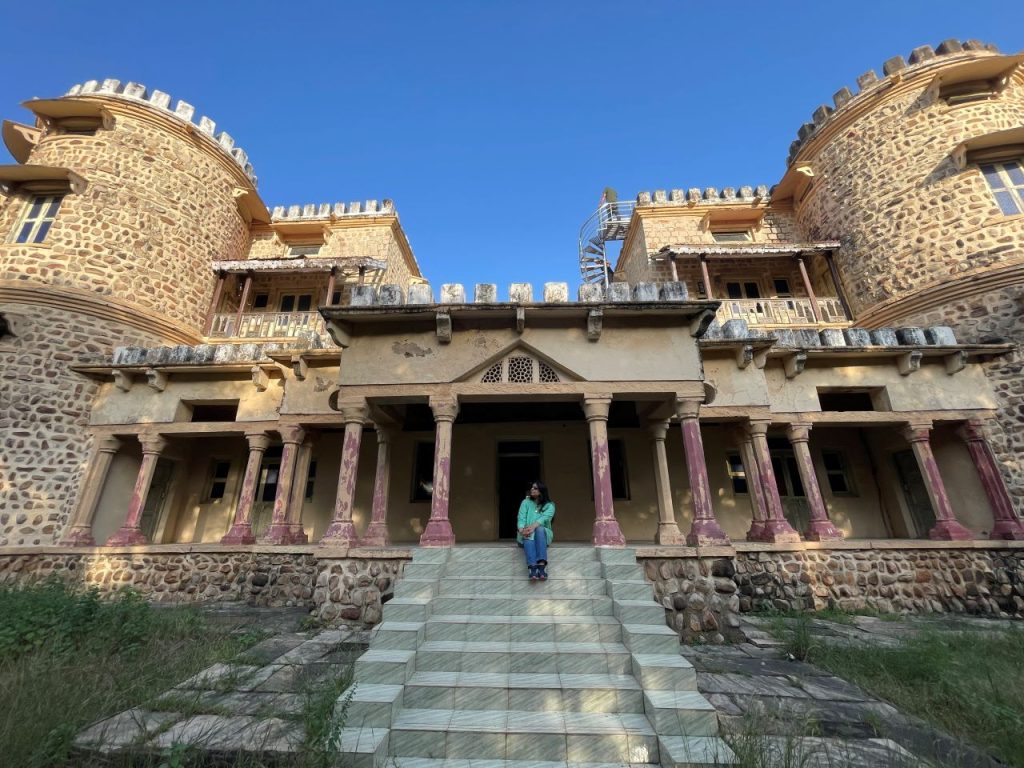
The king however did not stay in the castle, as he hunted a tiger on the way and returned without even seeing the castle built for him. We however climbed the charming castle and lost ourselves in the lush landscapes, watered by the lakes and springs. If you are lucky, you could even spot a sloth bear or nilgai from the tower. And you can also do a wildlife safari in Madhav Rao National Park,
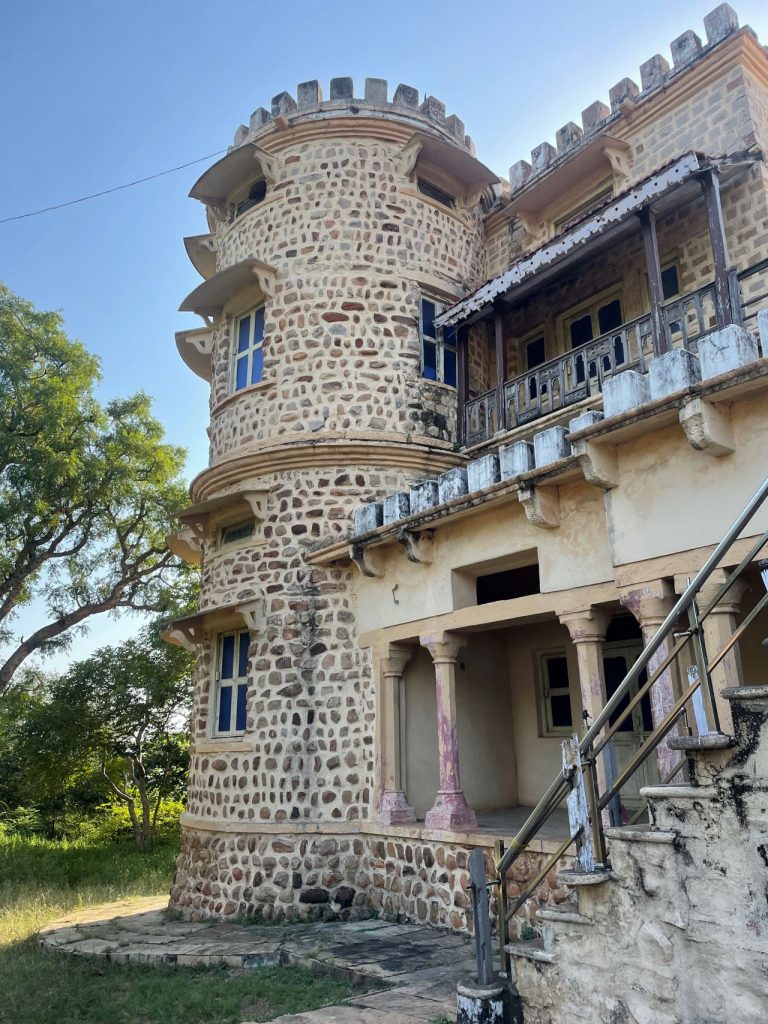
Places to see in Datia
Founded by the Bundela Rajputs, Datia located 80 km from Gwalior and 50 km from Orchha is an ancient town that has been mentioned in the Mahabharat as well. The entire old town is encircled by a fortified wall that has several old monuments and the 17th century Raja Bir Singh Palace, also referred to as the Datia Palace is the crown jewel. There are also several temples and pilgrimage sites here in Datia including the Pitambara Peeth, a Shaktipeeth, and the divine Sonagiri hill, a pilgrimage site for Jains with over 100 temples.
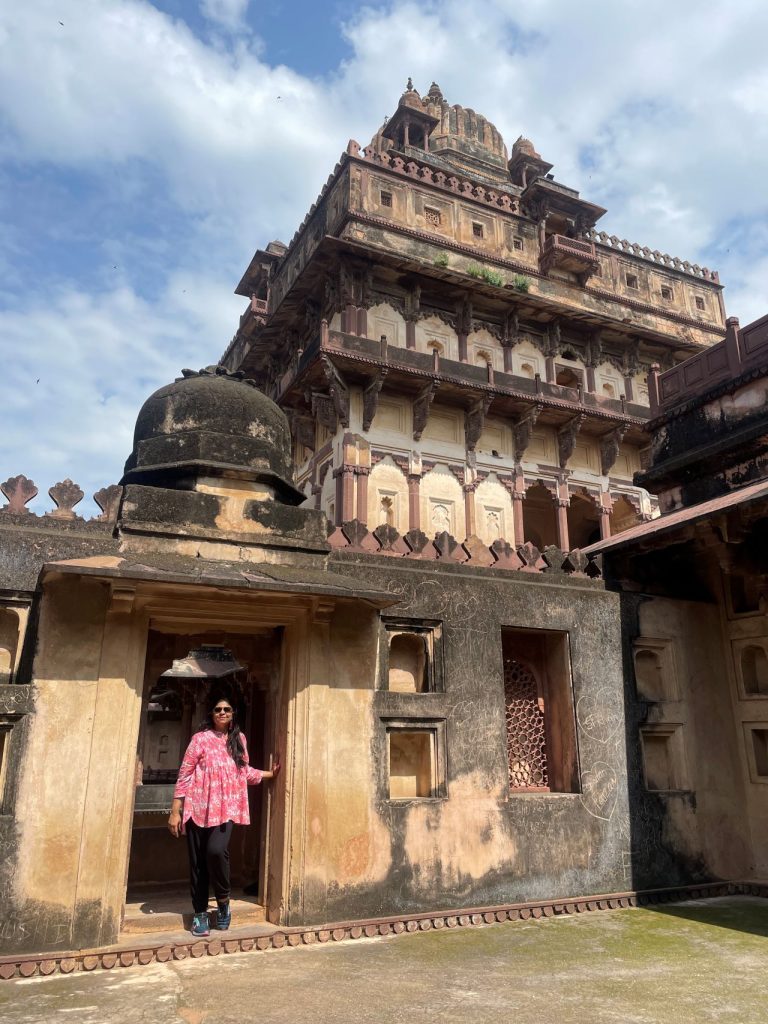
Datia Palace
If you want to know the story of Datia Palace in one sentence, then here it is.
Seven floors and 400 chambers, built over eight years, at an expense of 25 lakhs in the 17th century by one king for another, who stayed for just one night and then the palace was abandoned. This is the story of the Raja Bir Singh Deo Palace which was built for Mughal king Jahangir in Datia, which is located near Gwalior and Orchha.
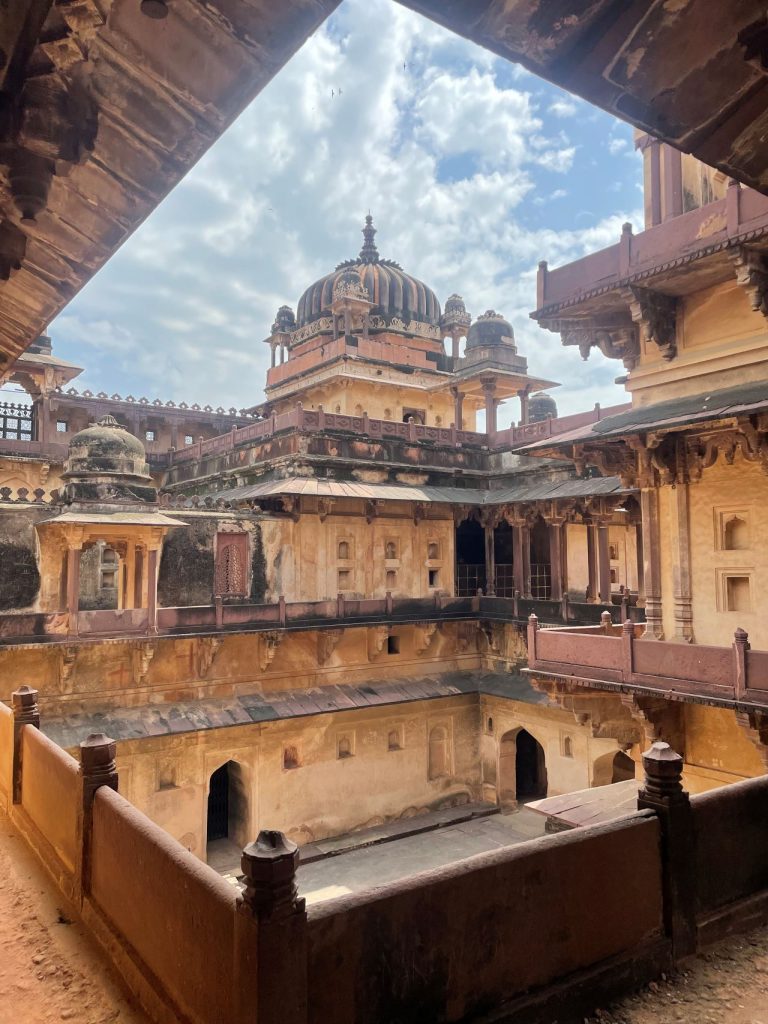
Built with just stones and bricks in a blend of Rajput and Mughal styles of architecture, each floor is breathtaking with fascinating paintings on the walls and has a story to tell. The first two floors were for armoury and defense, the third was for entertainment, the fourth floor was dedicated to guests and the sixth was for the queens while Jahangir stayed on the seventh floor. There are even make-up rooms and chambers for concubines.

And we climbed the seven floors of the Raja Bir Singh Deo Palace in Datia built by the Bundelkhand king for his friend and Mughal Ruler Jahangir under whose orders he had just beheaded Abul Fazl. When Jahangir became the ruler, he made Bir Singh the king of Bundelkhand and visited Datia for just one night. He stayed on the seventh floor and his view was not just the entire town of Datia but the head of the slain who was his nemesis.
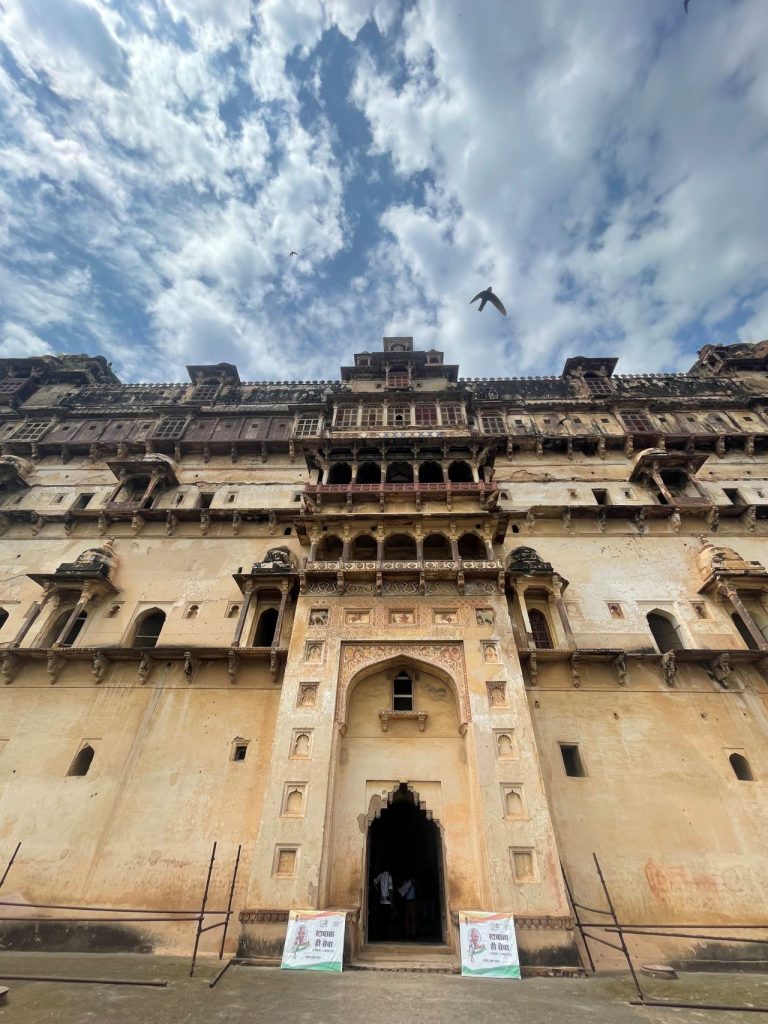
The Datia palace was one among the 50-odd monuments built by the Bundelkhand ruler for Jahangir and if you had visited Orchha you would hear a similar story in Jahangir Mahal. But this palace is a showstopper and a destination by itself and definitely one of the places to see around Gwalior.
Sonagiri

Sonagiri or Swarnagiri near Datia in Madhya Pradesh is one of the heritage destinations and a pilgrimage centre for Jains, mainly the Digambara Jain pilgrims. Located near Datia and a little over an hour by road from Gwalior, the sacred hill – Sonagiri or Swarnagiri has over 108 temples carved in white, and 77 of them are located atop the hill. It is believed that several monks have attained Moksha here. Hence it is also called Sonagiriji with respect.
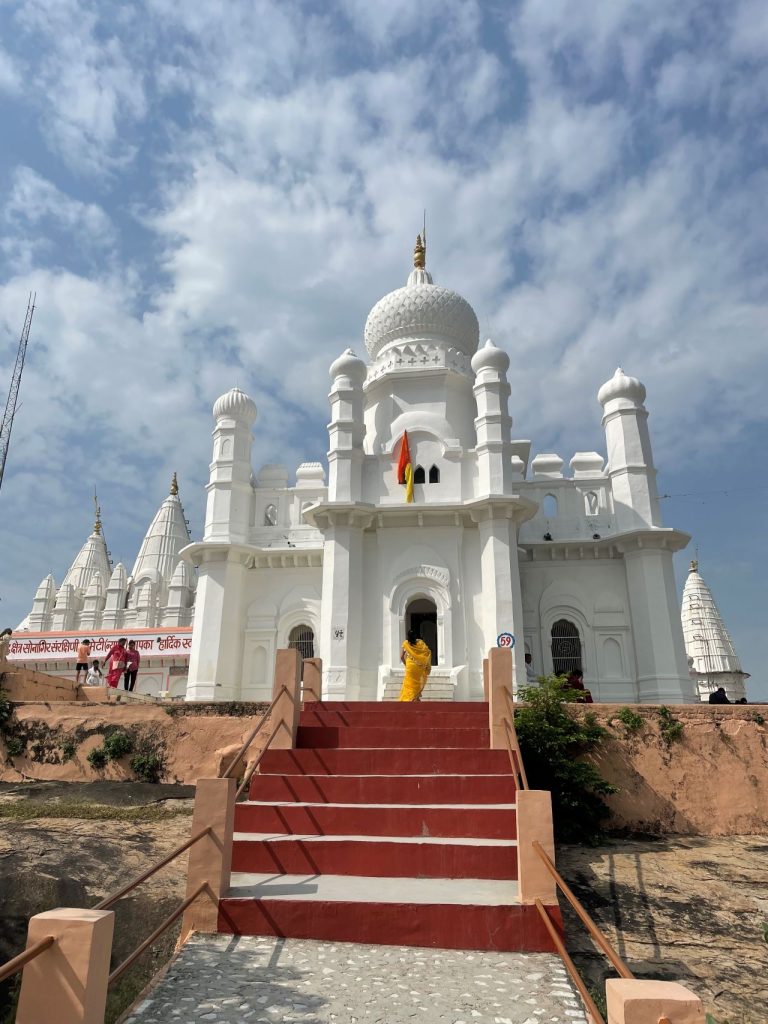
Dating back to the 9th century, the temples have a divine aura around them and there is a serene vibe that can only be experienced. The main temple numbered 57 is dedicated to Shri Chandraprabha, the 8th Teerthankara, who is fondly called “Bade Baba “ here. There is an ancient idol measuring over 11 feet and the belief is that the idol has originated here. The temple also has a 43-foot-tall Manasthamba, a sacred pillar that has carvings of four Teethankaras on top of it. There are several smaller shrines as well, both around this temple and across the hill.

Personally, for me, this was a very divine experience. Just being in this mystical hill, meditating at different shrines, and in harmony with nature – I felt an inexplicable sense of spiritual bliss.
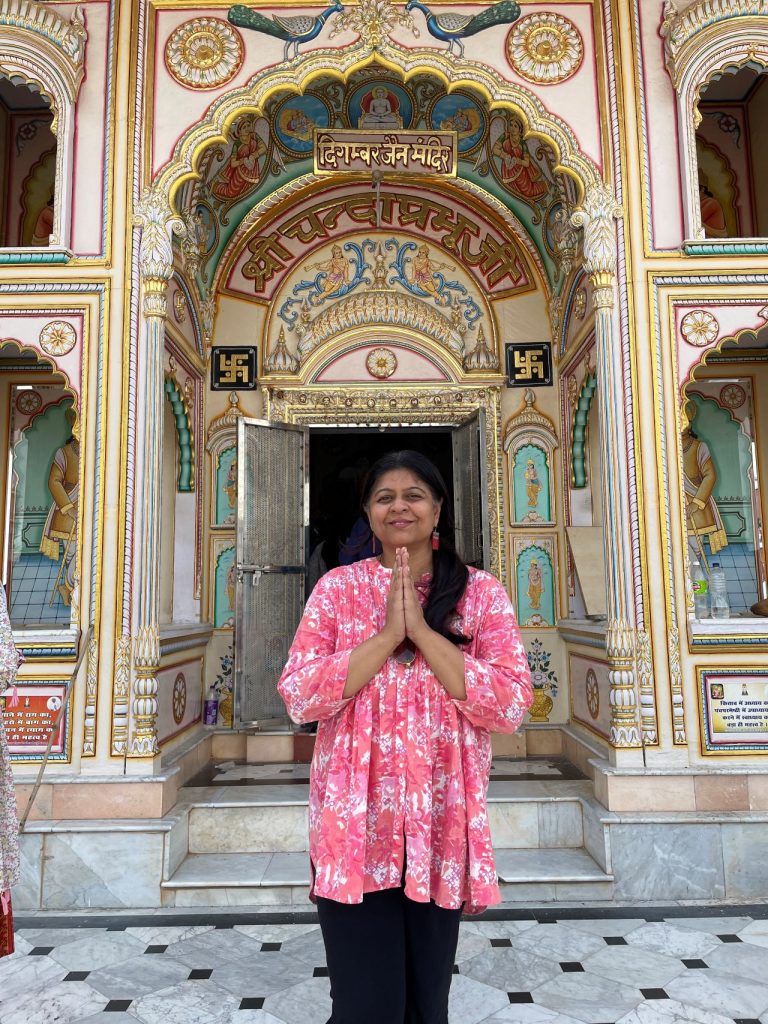
Peetambra Peeth
The Shaktipeetam dedicated to Maa Baglamukhi was established by Shree Swamiji who also consecrated a temple of Ma Dhumavati in the temple complex. Both the Goddesses are two of the ten Mahavidyas and the temple is dedicated to Maa Durga and Shakti. It is believed that the Shiva Linga in the Shri Vankhandeshwar Temple is so ancient that it even dates back to the era of the Mahabharata. There are other temples dedicated to Hanuman and Kala Bhairav in the temple complex. The Ashram here is maintained by a trust.
These are my recommendations for places to see around Gwalior. What would you like to suggest ?

